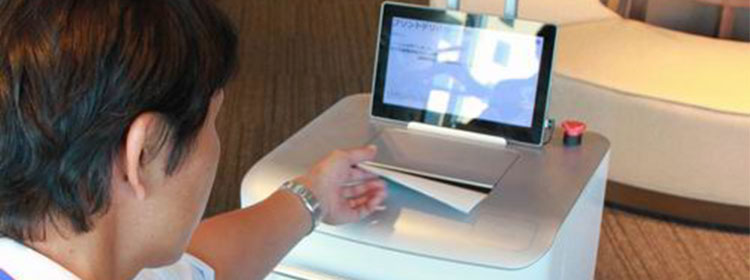Tomonori Shindou, Nikkei Computer
Fuji Xerox Co Ltd tested a printer that not only prints documents on paper but autonomously moves around a room like the Roomba robot cleaner for delivering it.
Fuji Xerox used a prototype of the robot in a building located in Aoyama, Minato-ku, Tokyo, in July and August 2014 in cooperation with Tokyu Land Corp for operation tests. Visitors to the lounge of the building used it for free.
The printing of documents is carried out via an Internet browser. Each desk in the lounge has a smart card on which a URL for printing is written. When the URL is accessed with a browser and a file is dragged and dropped in the browser window, an instruction to print out the file (print job) is sent to the robot.
When the robot receives a print job, it automatically begins to move toward the desk being used by the person who sent the order. Because it knows where in the lounge it is running, it stops near the desk.
The print job starts only after the user holds the card up to the robot. Therefore, the printed paper does not come out when the robot is moving in the lounge. As a result, business papers, etc will not be seen by others even in a public space like a lounge.
The robot houses a color laser printer of Fuji Xerox. It can handle sheets of up to A4 size. And it is the company’s smallest printer. On the top of the robot, a tablet computer is mounted. When the user presses the “start moving” button displayed on it after the printing job is done, it automatically goes back to the “home position” in a corner of the lounge.
Because the battery of the robot lasts for a day, it does not need to be charged in the home position.
For the autonomous movement function, the robot uses the “Lidar” sensors, which use laser to measure the three dimensional shapes of surrounding objects. While conventional radar devices use radio waves, the Lidar uses light (laser) instead so that more detailed information can be obtained in the range of several tens of meters.
The robot can automatically make a three-dimensional map of the lounge. If it is manually moved around a room at the time of introduction, a map for autonomous operation is made in the robot. It is not necessary to set up “markers” to be detected by sensors. When the robot detects an object that does not exist in the map, it sees the object as a human and selects a route so that it can avoid the person.







